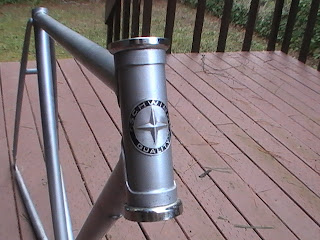The process of painting your frame is by far the
most difficult part of this project. However it's also the most
rewarding and it allows you to personalize your bike to your heart's
content.
Before we can apply
any paint to our frame we must first remove the paint currently on it.
This is important to allow for future paint to stick to the frame. Here
are the things we'll need for this:
Note that really the only reason for the toothbrush in this case is
because my paint remover is a paste rather than a spray. If you can find
a spray can of paint remover the toothbrush is completely unnecessary.
Some other things that you might find useful include sandpaper or even a
power sander. Also don't forget to use gloves and goggles when handling
the paint remover as it does burn your skin on contact.
To begin removing paint from the frame start by applying a generous
coat of paint remover to any areas covered in paint, avoiding areas that
are not such as the bottom bracket (inside the frame). After a few
minutes the paint will start to bubble and can then be easily chipped
off revealing the metal below.
Try to get as much paint off as you can,
you might even have to apply a second coat of paint remover. Eventually
you'll be left with just a few spots of paint which you can then remove
by hand with sandpaper.
Once you're satisfied with the amount of
paint removed from the frame, wipe any residual dust or oil from the
frame away with a wet paper towel. It's crucial that the frame is as
clean as possible for when you paint it.
Next tape up any chrome or decals with painter's tape and fill in any
holes in the frame with newspaper. You do not want any paint to get
inside the frame.
Now you're ready to paint. For the
best quality paint job possible with typical spray-paint we'll need to
use a primer and a clear epoxy in addition to our solid color.
For my bike I decided to go with a grey color. It's best if the color of your primer matches that of your top coat.
You'll want to wait for a warm dry day when painting. If you try and
paint in the cold or when it's very humid out your paint will run and
you'll end up with a horrible paint job. If it doesn't seem like it will
be warm any time soon you can also try and paint inside with the heat
turned on. But make sure you have very good ventilation if you do decide
to do this.
Regardless of
where you paint find somewhere to hang your frame up so that you can
paint all surfaces without having to touch it.
First apply a thin coat of
primer using quick straight motions to ensure that the paint doesn't
build up and drip. Once you have fully coated the frame repeat the
process a second and third time. You'll want at least three coats of
primer before you can apply the top coat. Once your primer dries take
the frame down and lightly sand the surface. This creates a rough
surface so that the next coat has no problem sticking. Next, apply two
or three layers of your top coat being just as careful to prevent the
paint from running. Lastly, after the paint has fully dried apply a few
players of clear epoxy. This gives the paint additional strength as well
as a nice shine. Here's my frame after all of the painting:
Finally remove all of the tape and newspaper to reveal your stunning new paint job.













Posting Komentar
Posting Komentar